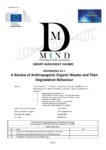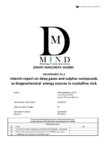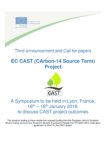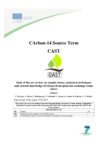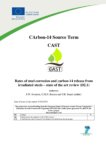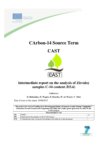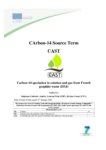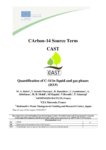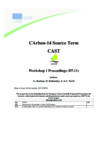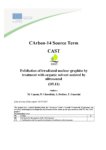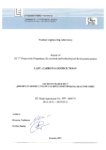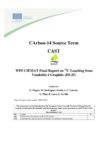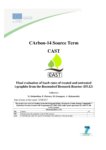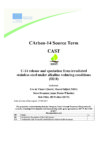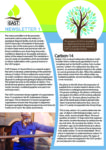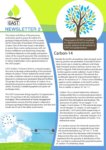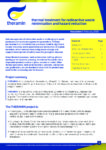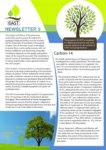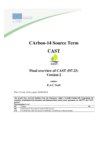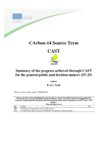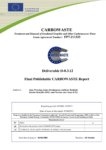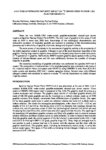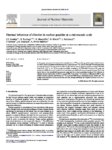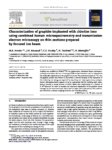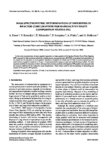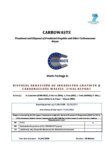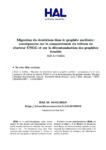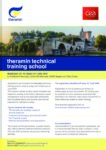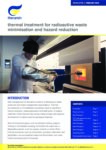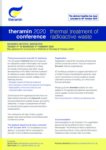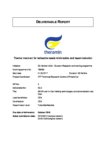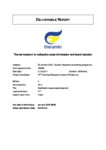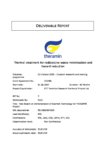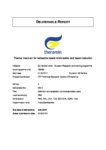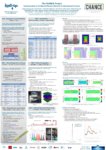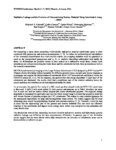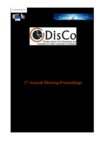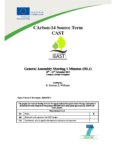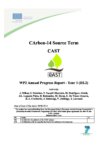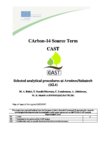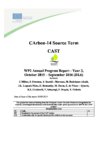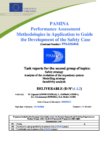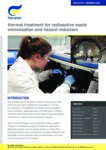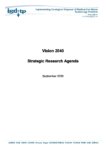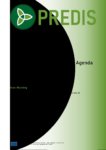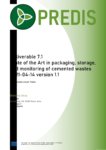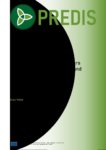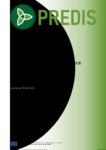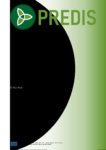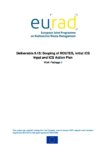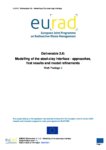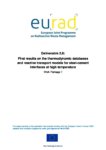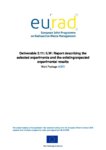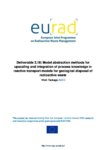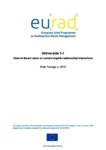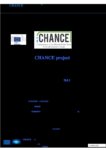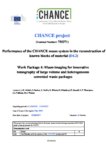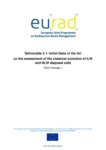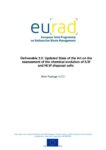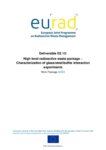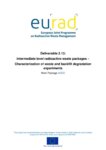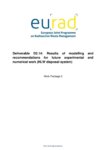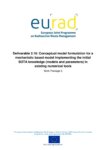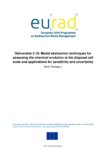Key Topic 2: Wasteforms and their Behaviour
Overview
This research area deals with understanding the behaviour of various wastes in geological repositories. All wastes that may require geological disposal are within the scope of this research area, thus including the waste categories of spent uranium oxide (UO2) and mixed oxide (MOX) fuels, vitrified high-level waste (HLW), long-lived intermediate level wastes (ILW) and some low-level wastes (LLW). Spent fuel from research reactors and legacy wastes are also considered. The wastes represent the potential source terms for release of radionuclides if and when waste containers are breached.
Objective
The purpose of the research within this research area is to understand safety-relevant processes, in particular the contribution of the wasteform to radionuclide retention in the repository. It is important to systematically define the physico-chemical properties of the waste materials, including their chemotoxic properties and presence of complexing agents, as well as the total inventory of various radionuclides – these properties together determine the time-dependent release of radionuclides. Methods for quantification of difficult-to-measure radionuclides are required here. This allows the formulation of mathematical models in order to assess radionuclide release from a repository. Spent nuclear fuel, when considered as the waste form for direct disposal, needs to be well characterised to address both pre-disposal and post-disposal issues. This characterisation is central for heat-output calculations and criticality safety analyses, which impact optimisation of repository plans and component requirements, and the definition of the initial state for the assessment of post-closure safety. Continued studies concerning how processes expected in the repository will affect the release rate of radionuclides from the spent fuel is required for both uranium oxide and MOX fuels. Understanding the waste source term directly relates to the first pillar of the IGD-TP’s Vision 2040, to “safely operate” disposal facilities, and also to the ability to optimise the design and operation of the repository (the second pillar, “optimise and industrialise”).
Related Documents
Description: Fourth MIND newsletter published in September 2017 (version 2).
Last updated: October 20, 2017
Description: Third MIND newsletter published in March 2017.
Last updated: March 20, 2017
Description: Second MIND newsletter published in October 2016.
Last updated: October 20, 2016
Description: First MIND newsletter published in March 2016.
Last updated: March 20, 2016
MIND 2017 D3.4 Year 2 Synthesis Report
Description: MIND deliverable D3.4 published July 2017. This report is a synthesis of the outcome of the experimental and modelling research activities in MIND WP1 and WP2, performed over the first 2 years of the project. The scope of the report is broad, covering all completed scientific and ‘in progress’ projects contained within MIND. The emphasis in this report is on the description of the degradation processes that can be expected and the environmental boundary conditions under which they can occur. The kinetics of these processes are not featured prominently here, but will become an increasingly prioritised aspect of the MIND project throughout the remainder of its tenure, and a next update of this report.
Last updated: July 20, 2017
MIND 2016 D3.1 Year 1 Evaluation Report
Description: MIND deliverable D3.1 published October 2016. This year one evaluation report of MIND consists of two parts. The first part is a description of the state of the art of geological disposal of radioactive waste, with a special reference to microbiological issues. The second part is the first year evaluation of the microbial processes studied in MIND Work Packages 1 and 2.
Last updated: October 20, 2016
MIND 2015 D1.1 A Review of Anthropogenic Organic Wastes and Their Degradation Behaviour
Description: MIND Deliverable D1.1, published December 2015. Work Package 1 of the MIND project addresses remaining key issues for the geological disposal of ILW concerning the long-term behaviour, fate and consequences of organic materials in the waste along with H2 generated by corrosion and radiolysis. This review begins this work by collating information concerning the inventory and nature of organic materials present in ILW and some LLW that requires geological disposal. The review has then considered the physical and chemical conditions that the organic materials will be subjected to during storage and geological disposal. The review then provides a summary description of the physical and chemical nature of the main organic materials present in ILW and their known chemical and radiolytic degradation behaviour. The effect of the organic degradation products on radionuclide speciation, which could affect how some radionuclides are transported in groundwater, is then considered to focus subsequent work in this field.
Last updated: December 20, 2015
MIND 2016 D2.1 Inventory of reducing gases
Description: MIND Deliverable D2.1, published November 2016. In order to provide data needed to address the question on geochemical constraints of biological activity at spent nuclear fuel waste repository sites, geochemical data of dissolved gases from deep drill holes and mines in Finland and Sweden were collected based on a literature and database survey. Gas data were found from 20 separate localities in Finland with the deepest drill holes extending down to 2500 m below surface. The gas phase is dominated by nitrogen and methane, although significant variation exists between different sites and with depth. At least partly this variation can be related to differences in lithology (rock types) and residence time of water within the bedrock. Corresponding data from Sweden were from 2 localities extending to at most 1000 m below surface.
Last updated: November 20, 2016
MIND 2016 D3.3 Modular microbiology education and training
Description: MIND Deliverable D3.3, published November 2016. The overall aim of both the education and training initiatives in MIND is to cultivate awareness of the relevance of microbial issues in otherwise typically abiotic fields of expertise, and dissipate the knowledge gained in the MIND project beyond the known geomicrobiology expert circles. For this reason, modular training courses were developed, an exchange programme for Master and PhD students has been developed and focused communication on these initiatives has been undertaken.
Last updated: November 20, 2016
Description: MIND Deliverable D2.3, published August 2017. Geochemical data on sulphur compounds and dissolved gases from deep drill holes and deep mines in Finland were compiled into a database. Data is used as background for MIND work package 2, in which microbial production of sulphide in the geosphere will be assessed from the point of view of canister corrosion. This report summarises the present knowledge on the mode of occurrence of sulphur compounds and dissolved gases in groundwaters of crystalline bedrock. Prerequisites of microbial sulphate reduction are discussed based on the data available.
Last updated: August 20, 2017
MIND 2019 D2.4 Bacterial presence and activity in compacted bentonites
Description: MIND Deliverable D2.4, Version 2, published April 2019. It has been hypothesised that cut-off bentonite density thresholds exist above which all bacterial activity stops or is inhibited to a such a level that it can be regarded as negligible. This report discusses if that hypothesis can be considered true or if more variables other than clay density determine bacterial activity in bentonites. The clays analysed and discussed in this report have been investigated previously. This deliverable summarizes previously performed work and new work performed within MIND.
Last updated: May 2, 2019
CAST Final General Assembly – Third announcement and call for papers
Description: Third announcement and call for papers for the CAST final general assembly in Lyon, France, on 16-18 January 2018.
Last updated: October 20, 2017
CAST 2014 D3.1 State of the art of 14C in Zircaloy and Zr alloys
Description: CAST - This report provides a review of the current status of knowledge on various aspects related to the release of 14C from zirconium alloys waste (hulls), which is of importance for long-term safety analyses of final repositories for long-lived Intermediate level waste.
Last updated: September 23, 2014
CAST 2015 D4.1 State of art review of spent ion exchange resins
Description: CAST - A state of the art review on the different techniques used to characterize spent ion exchange resins is presented. A large part of the works that were done so far are based on liquid scintillation counting, but an increasing amount of determination are now performed in accelerator mass spectrometry. Other non-conventional techniques are also reviewed. Finally, a status of knowledge is provided on the possible chemical forms (speciation) under which 14C can be released from spent ion exchange resins. Analytical strategies for speciation by partners are also described. Available estimations of the proportion of inorganic vs. organic forms are reviewed as well as the possibility of the different forms of organic molecules, and gaseous release.
Last updated: February 23, 2015
CAST 2015 D2.1 State of the art review of steel corrosion and C14 release
Description: CAST - The objective of this report is to review the current state of understanding of steel corrosion rates and carbon-14 releases from irradiated steels under conditions relevant to the storage and long-term disposal of radioactive wastes and thereby incorporate information available from outside the CAST project into CAST WP2.
Last updated: February 23, 2015
CAST 2015 D3.6 Intermediate report on the analysis of samples total C14 content
Description: CAST - D3.6 forms part of CAST task 3.3 “Characterisation of C-14 released from irradiated Zirconium fuel clad wastes”. This report summarises the progress at ITU to the end of March 2015.
Last updated: June 23, 2015
Description: CAST - To ensure knowledge and understanding from the CARBOWASTE project is thoroughly considered in the CAST project, Task 5.1 is being undertaken in the first year of CAST. This task is the subject of the current report, and has the aim to review CARBOWASTE and other relevant R&D activities to establish the current understanding of inventory and release of carbon-14 from irradiated graphites.
Last updated: July 23, 2015
CAST 2016 D6.1 C14 in safety assessments
Description: CAST - The first phase of WP6, prior the analysis of the experimental results delivered by the project, aims at taking stock of the C-14 knowledge from the angle of safety assessments. Deliverable D6.1 gives an overview on this for each national program. On the basis of this compilation, commonalities and differences between disposal concepts regarding the impact of the uncertainties linked to C-14 release from radioactive waste disposal will be identified as well as the way to cope with them. This thorough discussion will be the object of deliverable D6.2.
Last updated: January 23, 2016
CAST 2016 D5.3 Reports on graphite categories in the RBMK reactor
Description: CAST - This report presents information on graphite characterisation as is being undertaken as part of the Chernobyl Nuclear Power Plant Decommissioning Program. Work considering chemical decontamination of graphite is reported, as is the overall graphite waste management approach.
Last updated: March 23, 2016
CAST 2016 D5.8 Synthesis report on 14C speciation in solution and gas from French graphite waste
Description: CAST - Carbon 14 is one of the key radionuclides for the future disposal of French irradiated graphite waste. It is one of the main long-lived radionuclides, and depending on its speciation, it can be more or less mobile in a disposal facility and more or less incorporated into living organisms. Following a first report concerning a review of the available leaching data of French irradiated graphite, particularly focused on carbon 14 release rates (D5.1), this second report (D5.8) addresses the speciation of the released carbon 14.
Last updated: April 23, 2016
CAST 2016 D5.7 Report on C14 distribution in irradiated graphite from research reactor VVR-S
Description: CAST - The main objective of the IFIN-HH in the second year of its input to Work Package 5 was to update the inventory of 14C in the irradiated graphite arising from thermal column of VVR-S Reactor and radioactive wastes containing organic and inorganic 14C compounds. IFIN-HH has characterized the 14C inventory of irradiated graphite from thermal column of VVR-S Reactor, and has started to develop a method, based on the use Accelerator Mass Spectrometry (AMS) which will be suitable to characterize the distributions of14C inventory in irradiated graphite. Finally, in order to measure the total release of 14C (and 3H) to solution and gas from crushed and intact i-graphite from the VVR-S Reactor, the experimental apparatus has been designed and manufactured.
Last updated: July 23, 2016
CAST 2017 D3.9 Quantification of C14 in liquid and gas
Description: CAST - This report presents the work developed by SUBATECH, CEA and RWMC.
Last updated: March 23, 2017
CAST 2017 D7.11 Proceedings of the First Workshop
Description: CAST - The 1st Workshop of the CAST project was held 5 - 6 October 2016 at the COVRA facilities, Vlissingen, Netherlands. Presentations were given showing the status of project work and scientific-technical achievements, but also how the project work falls in the wider context. A series of topics were identified where R&D is still required in order to obtain the desired confidence in safety for geological disposal of the concerned waste materials. This is also relevant for the question to which extent confidence in safety for disposal in less ambitious facilities than deep geological ones can be justified, with or without pre-treatment of the waste material.
Last updated: March 23, 2017
CAST 2017 D2.7 Report on C14 release speciation from carbon steel under alkaline reducing conditions
Description: CAST - The aim of the work at SCK•CEN in the framework of Work Package 2 of the CAST project was to investigate the release of 14C from carbon steels representative for the reactor pressure vessel (RPV) steel of Belgian nuclear power plants and the 14C speciation in a cementitious environment, which is relevant for the Belgian geological disposal concept, which involves placing the RPV steel in a concrete monolith.
Last updated: July 23, 2017
CAST 2017 D2.11 Report on C14 release speciation from stainless steel under acidic conditions
Description: CAST - In this report the work performed by the Karlsruhe Institute of Technology (KIT) with support from the National Cooperative for the Disposal of Radioactive Waste (NAGRA, Switzerland) within the work package 2 of the CAST project is summarized. In the following sections, the thermodynamic modelling of 14C in metals is presented as well as the experimentally determined 14C inventory in irradiated steel and the chemical form of 14C released from the studied material.
Last updated: July 23, 2017
CAST 2017 D2.12 Report on C14 release speciation from stainless steel
Description: CAST - RWMC has studied the aqueous corrosion of non-irradiated stainless steel under simulated repository conditions.
Last updated: July 23, 2017
CAST 2017 D5.11 Report on exfoliation processes and on structural and morphological properties
Description: CAST - In this deliverable, the behaviour of nuclear graphite through the exfoliation process has been studied, carried out with different organic solvents to remove primarily radiocarbon and estimate the “Removal Efficiency“ (as percentage of the recovered activities after treatment in comparison to the original values) of the used solvents in order to propose a reliable approach to produce graphite for recycling or/and safety disposed as L&ILW.
Last updated: July 23, 2017
CAST 2017 D5.17 Report on modelling of 14C inventory in RBMK reactor core
Description: CAST - This report is one of the CAST Work Package 5 (WP5) deliverables and it presents results of Lithuanian Energy Institute (LEI) activities performed in the Task 5.2 “Characterisation of the C-14 inventory in i-graphites”.
Last updated: July 23, 2017
CAST 2017 D6.2 Knowledge supporting safety assessments of 14C
Description: CAST - Work Package 6 of the CAST project is devoted to the knowledge base concerning the re-lease and transport of 14C in the context of post-closure safety assessments of the geological disposal of radioactive waste. This report (D6.2) assesses the various approaches for safety assessment discussed in report D6.1 in the light of the existing knowledge about the 14C source term. It proposes a synthesis of D6.1, identifies commonalities and differences between approaches and concepts and highlights safety-critical uncertainties pertaining to 14C fate in waste disposal.
Last updated: July 23, 2017
CAST 2017 D5.14 Release of C14 from irradiated VVR-S graphite to solution and gas phases
Description: CAST - Irradiated graphite, dismantled from the thermal column of VVR-S Reactor, contains different radioisotopes as activation products, including carbon-14 (C-14) and tritium (H-3). In repository-relevant conditions, this graphite could be a source of gases containing C-14 and H-3. In the experiments performed by IFIN-HH we have investigated the release of C-14 and H-3 from two intact samples of irradiated graphite which have been cut from the thermal column disc located near the reactor core.
Last updated: August 23, 2017
CAST 2017 D5.15 Final report on 14C leaching from Vandellos graphite
Description: CAST - The development of both analytical methods and protocols to measure the release of 14C from irradiated graphite samples and the speciation in the aqueous and gaseous phase has been performed throughout the CAST project. Analytical methods, suited to identify and quantify low molecular weight organic molecules, comprise Ion Exchange Chromatography and Gas Chromatography coupled to Mass Spectrometry, they are described for aqueous and gaseous samples. Also, the preparation of the leaching experiments to measure the release of 14C is described in this report.
Last updated: August 23, 2017
CAST 2017 D5.12 Final evaluation of leach rates of treated and untreated i-graphites
Description: CAST - Work Package 5 of the EC CAST project considers the behaviour of 14C i-graphite. In particular, the work is focused on understanding the factors determining the release of 14C from irradiated graphite (hereafter “i-graphite") under disposal conditions (including surface disposal facilities and deep geological disposal facilities). In this study, the release of 14C was investigated in model experiments with i-graphite from the Rossendorf Research Reactor (RFR).
Last updated: September 23, 2017
CAST 2017 D5.18 Report on 13C behaviour under ion irradiation in HOPG model (model graphite)
Description: CAST - The aim of work undertaken by IPNL is to simulate the behaviour of 14C during reactor operation and evaluate the independent or synergistic effects of temperature and irradiation on 14C behaviour.
Last updated: September 23, 2017
Description: CAST - This report is deliverable D2.8 of the CAST project. In this deliverable, the details about the experiments focusing on the study of C-14 release form irradiated steel are presented. It includes the samples, experiment design, description of analytical methods, experiment and its results, and discussions of the results. This deliverable describes results up to 5 months of running the experiment.
Last updated: October 23, 2017
CAST 2017 D7.9 All course notes for training course 1
Description: CAST - This report contains the presentations made at Training Course 1 of CAST held on 5th and 6th July 2016 at Karlsruhe Institute of Technology.
Last updated: June 23, 2017
DISCO Deliverable D1.3 – 2017 Newsletter #1
Description: First DISCO newsletter (D1.3).
Last updated: August 23, 2017
CAST 2016 D7.11 Proceedings of Workshop 1, 5-6 October 2016
Description: CAST - This report is deliverable D7.11 of the CAST project, detailing the proceedings of workshop 1 held on 5-6 October 2016.
Last updated: December 20, 2017
THERAMIN Newsletter 1 (Jan 2018)
Description: First THERAMIN newsletter (March 2018).
Last updated: March 2, 2018
Description: Fifth MIND newsletter published in April 2018.
Last updated: May 7, 2018
CAST 2018 WP2 Steels Deliverables
Description: Zip file of all publicly available deliverables from the CAST project produced under Work Package 2: Steels.
Last updated: September 27, 2018
CAST 2018 WP3 Zircaloy Deliverables
Description: Zip file of all publicly available deliverables from the CAST project produced under Work Package 3: Zircaloy.
Last updated: September 27, 2018
CAST 2018 WP4 Ion Exchange Resins Deliverables
Description: Zip file of all publicly available deliverables from the CAST project produced under Work Package 4: Ion Exchange Resins.
Last updated: September 27, 2018
CAST 2018 WP5 Graphite Deliverables
Description: Zip file of all publicly available deliverables from the CAST project produced under Work Package 5: Graphite.
Last updated: September 27, 2018
CAST 2018 WP6 Safety Case Relevance Deliverables
Description: Zip file of all publicly available deliverables from the CAST project produced under Work Package 6: Safety Case Relevance.
Last updated: September 27, 2018
CAST 2018 D7.20 Workshop 2 Report
Description: CAST deliverable D7.20, report of workshop 2.
Last updated: September 27, 2018
Description: CAST deliverable D7.22, newsletter 5.
Last updated: September 27, 2018
CAST 2018 D7.23 Final Overview of CAST
Description: CAST deliverable D7.23, Final Overview of CAST.
Last updated: September 27, 2018
CAST 2018 D7.24 Summary of Scientific Progress Achieved
Description: CAST deliverable D7.24, Summary of Scientific Progress Achieved Through CAST.
Last updated: September 27, 2018
CAST 2018 D7.25 Summary of Scientific Progress Achieved- For Public and Decision-makers
Description: CAST deliverable D7.25, Summary of Scientific Progress Achieved Through CAST for the general public and decision-makers.
Last updated: September 27, 2018
Description: Sixth MIND newsletter published in October 2018.
Last updated: October 29, 2018
MIND Project Annual Meeting 2019 – Flyer2
Description: Flyer for MIND Project Annual Meeting 2019.
Last updated: November 27, 2018
DISCO Deliverable D1.9 – 2018 Newsletter #2
Description: Second DISCO newsletter, June 2018.
Last updated: January 11, 2019
CARBOWASTE 2013 D0.3.12 Final Report
Description: CARBOWASTE deliverable D0.3.12, Final Report.
Last updated: February 20, 2019
CARBOWASTE 2008 An Integrated Approach to Irradiated Graphite
Description: CARBOWASTE 2008, project paper, An Integrated Approach to Irradiated Graphite
Last updated: February 20, 2019
CARBOWASTE 2008 Treatment and Disposal of Irradiated Graphite and other Carbonaceous Waste
Description: CARBOWASTE 2008, project paper, Treatment and Disposal of Irradiated Graphite and other Carbonaceous Waste
Last updated: February 20, 2019
CARBOWASTE 2009 Analysis of Nitrogen Impurity Impact on 14C Generation in RBMK-1500 Reactor Graphite
Description: CARBOWASTE 2009, project paper, Analysis of Nitrogen Impurity Impact on 14C Generation in RBMK-1500 Reactor Graphite
Last updated: February 20, 2019
CARBOWASTE 2009 Thermal Behaviour of Chlorine in Nuclear Graphite at a Microscopic Scale
Description: CARBOWASTE 2009, project paper, Thermal Behaviour of Chlorine in Nuclear Graphite at a Microscopic Scale
Last updated: February 20, 2019
Description: CARBOWASTE 2010, project paper, Characterization of graphite implanted with chlorine ions using combined Raman microspectrometry and transmission electron microscopy on thin sections prepared by focused ion beam
Last updated: February 20, 2019
Description: CARBOWASTE 2010, project paper, Mass Spectrometric Determination of Impurities in Reactor Core Graphite for Radioactive Waste Composition Modelling
Last updated: February 20, 2019
Description: CARBOWASTE 2011, project paper, On a Reliable Structural Characterization of Polished Carbons in Meteorites by Raman Spectroscopy
Last updated: February 20, 2019
Description: CARBOWASTE 2013, project deliverable D6.0.0, Disposal Behaviour of Irradiated Graphite and Carbonaceous Wastes - WP6 Final Report
Last updated: February 20, 2019
CARBOWASTE 2015 Thesis: Migration du deutérium dans le graphite nucléaire
Description: CARBOWASTE 2015, thesis, Migration du deutérium dans le graphite nucléaire: conséquences sur le comportement du tritium en réacteur UNGG et sur la décontamination des graphites irradiés
Last updated: February 20, 2019
THERAMIN Technical Training School Flyer
Description: THERAMIN project, flyer for a technical training school at Le Visiatome Marcoule, Centre CEA Marcoule, France (12–14 June 2019).
Last updated: March 5, 2019
THERAMIN Newsletter 2 (Feb 2019)
Description: THERAMIN project, Newsletter 2, February 2019
Last updated: March 6, 2019
THERAMIN Conference 2020 Flyer
Description: THERAMIN project, flyer for the 2020 conference. Abstract deadline has been extended to 18th October 2019.
Last updated: March 6, 2019
Description: MIND Deliverable D2.16. This report describes the impact of microbe-clay-radionuclide interactions in laboratory experiments designed to investigate microbial survival and activity in compacted bentonites and how this affects the physical-, chemical- and transport-properties of the clay.
Last updated: July 30, 2019
MIND Deliverable D2.12 – Microbial activity in a concrete-bentonite clay inteface
Description: MIND Deliverable 2.12, published 28 May 2018. The aim of this work was to analyse the effect of concrete on pH of the bentonite as well as microbial survival in the bentonite.
Last updated: July 30, 2019
MIND Deliverable D2.10 – Microbial mobility in saturated bentonites of different density
Description: MIND Deliverable 2.10, published 30 June 2018. Our study fulfilled two most important goals. First, we developed a reliable method for direct detection of bacterial presence (both viable and dead cells) in the bentonite, which has been missing. Our method is based on the extraction of bacteria from bentonite using density gradient centrifugation and their subsequent Live/Dead fluorescence staining. Although our method needs further optimization and testing of its general functionality on different bentonite types, we believe it will be very useful for future research of bacterial presence in various clay materials.
Last updated: July 30, 2019
MIND Deliverable D2.9 – Evolution of stress in biotic and abiotic clay flow cells
Description: MIND Deliverable 2.9, published 13 July 2018. Microbial activity has been implicated in both the corrosion of steel material and alteration of bentonite clays used in geological disposal facilities for radioactive waste. To understand the limits on microbial growth and the potential for microbial activity in this environment to affect the swelling behaviour of the clay and metal corrosion, a series of laboratory experiments were performed. The experiments described here were designed to investigate multiple effects of microorganisms (on steel corrosion, changes to bentonite swelling capacity, permeability and fluid flow) in a single set of laboratory scale flow experiments using compacted bentonite samples.
Last updated: July 30, 2019
MIND Deliverable D2.8 – Long-term stability of bentonite in the presence of microorganisms
Description: MIND Deliverable 2.8, published 30 June 2018. This report address the question whether microbial activity could influence the beneficial properties of the bentonite by either changing the solubility or composition of minerals and/or important ions like ferric and ferrous iron.
Last updated: July 30, 2019
MIND Deliverable D2.7 – Microbial diversity in aged bentonites
Description: MIND Deliverable 2.7, published 30 July 2018. In this work, we studied a diversity of the microbial communities present in the compacted bentonites originating from two independent long-term in situ experiments (“Mock-Up experiment” and “Bentonite95 experiment”) performed under near field conditions. The compacted bentonite buffer was exposed under conditions similar to a high-level radioactive waste repository in crystalline host rock. We employed 16S rDNA amplicon sequencing to determine the microbial profiles in different parts of bentonite samples.
Last updated: July 30, 2019
MIND Deliverable D2.6 – Microbial diversity in bentonite buffer of aged bentonite buffer experiment
Description: MIND Deliverable 2.6, published 20 June 2018. This report describes the results obtained from the long-term experiment with bentonite buffer. The MX-80 Na-bentonite was compacted inside a copper cylinder, which was set inside a plastic bottle containing non-saline groundwater simulant. The aim of this experiment was to evaluate changes of chemical, mineralogical and microstructural parameters of bentonite in both oxic and anoxic conditions. Microbiological analyses performed at the end of the experiment included evaluation of bacterial and fungal communities by sequencing and visual evaluation microscopically.
Last updated: July 30, 2019
MIND Deliverable D1.5 – Microscopy and element mapping characterization studies of radionuclide
Description: MIND Deliverable 1.5, published 15 June 2018. The main objectives of this study is to determine the role of Stenotorphomonas bentonitica, bacterial strain isolated from Spanish bentonites on the mobility and migration of radionuclides (Se(IV), Se(VI) and Eu(III)) under DGR relevant conditions using a multidisciplinary approach combining microscopy, spectroscopy, cell biology, radiochemistry, microbiology, etc.
Last updated: July 30, 2019
MIND Deliverable D4.5 – Publication Plan
Description: MIND Deliverable 4.5, published 31 August 2018.
Last updated: July 30, 2019
MIND Deliverable D3.4 – Year two synthesis report
Description: MIND Deliverable 3.4, published 14 July 2017. This report is a synthesis of the outcome of the experimental and modelling research activities in WP1 and WP2, performed over the first 2 years of the project. The scope of the report is broad, covering all completed scientific and ‘in progress’ projects contained within MIND. The emphasis in this report is on the description of the degradation processes that can be expected and the environmental boundary conditions under which they can occur. The kinetics of these processes are not featured prominently here, but will become an increasingly prioritised aspect of the MIND project throughout the remainder of its tenure, and a next update of this report.
Last updated: July 30, 2019
MIND Deliverable D2.3 – Interim report on deep gases and sulphur compounds.
Description: MIND Deliverable 2.3, published 16 August 2017. Geochemical data on sulphur compounds and dissolved gases from deep drill holes and deep mines in Finland were compiled to a database. Data is used as a background of MIND work package 2, in which microbial production of sulphide in the geosphere will be assessed from the point of view of canister corrosion. This report summarizes the present knowledge on the mode of occurrence of sulphur compounds and dissolved gases in groundwaters of crystalline bedrock. Prerequisites of microbial sulphate reduction are discussed based on the data available.
Last updated: July 30, 2019
MIND Deliverable D3.3 – Modular microbiology education and training
Description: MIND Deliverable D3.3, published 10 November 2016. The overall aim of both the education and training initiatives in MIND is to - cultivate awareness of the relevance of microbial issues in otherwise typically abiotic fields of expertise, and- - dissipate the knowledge gained in the MIND project beyond the known geomicrobiology expert circles. For this reason, modular training courses were developed, an exchange programme for Master and PhD students has been developed and focused communication on these initiatives has been undertaken.
Last updated: July 30, 2019
MIND Deliverable D2.2 – Design, set up and operation of experimental equipment
Description: MIND Deliverable D2.2, published 17 November 2016. A laboratory scale experiment investigating the impacts of microbial activity on bentonite structure has been started at VTT. The experiment simulates a worst case scenario where bentonite is not compacted, water, gases, nutrients and microorganisms are able to move along easily at temperature hospitable for microbial welfare. The aim is to find out if microorganisms and the produced metabolites are able to change the bentonite structure in favourable conditions and if these changes are significant for the bentonite ability to function in long-term scale. The experiment will be monitored with microbial sampling as well as with atomic force microscopy (AFM) once a year.
Last updated: July 30, 2019
MIND Deliverable D2.1 – Inventory of reducing gases
Description: MIND Deliverable D2.1, published 22 November 2016. In order to provide data needed to address the question on geochemical constraints of biological activity at spent nuclear fuel waste repository sites, geochemical data of dissolved gases from deep drill holes and mines in Finland and Sweden were collected based on a literature and database survey. Gas data were found from 20 separate localities in Finland with the deepest drill holes extending down to 2500 m below surface. The gas phase is dominated by nitrogen and methane, although significant variation exists between different sites and with depth. At least partly this variation can be related to differences in lithology (rock types) and residence time of water within the bedrock. Corresponding data from Sweden were from 2 localities extending to at most 1000 m below surface.
Last updated: July 30, 2019
Description: MIND Deliverable 3.2-1, published 19 April 2015. This deliverable presents the methodological plan for the development of guidelines for risk communication in the context of microbiology research for nuclear waste disposal. The outcome of this study will support the design of communication guidelines for the project objectives and results during and after its implementation.
Last updated: July 30, 2019
MIND Deliverable D4.4 – Data Management Plan (DMP)
Description: MIND Deliverable D4.4, published 1 December 2015. Within the MIND-project we have decided to create a common Data Management plan which is this document. The document will be updated continuously by the project members on Syncplicity whenever new datasets are made available. An updated version will be published at the end of each reporting period.
Last updated: July 30, 2019
MIND Deliverable D4.3 – Dissemination and Exploitation Plan (DEP)
Description: MIND Deliverable D4.3, published 1 December 2015. In this report the plan for dissemination and exploitation are described in more detail, including a detailed delineation of timing that will be updated over time. The dissemination and exploitation activities of the MIND consortium are coordinated by the SKB. It will allow the project outcome to be returned to the society, who supported and funded the research, by providing information, promoting the consortium and its work, raising awareness and engaging the community in the project.
Last updated: July 30, 2019
MIND Deliverable D4.2 – Project Presentation (PP) Compilation
Description: MIND Deliverable D4.2, published 15 September 2015.
Last updated: July 30, 2019
MIND Deliverable D4.1 – Project homepage
Description: MIND Deliverable D4.1, published 1 September 2015.
Last updated: July 30, 2019
THERAMIN Deliverable D3.3 – SHIVA and In-Can Melting technologies and demonstration test trials
Description: THERAMIN Deliverable D3.3, published 14 June 2019. This report describes two trials - first, the SHIVA incineration-vitrification process, combining heating by transferred arc plasma and direct induction, and second, the In-Can Melter trial, which was designed to vitrify inactive ash coming from the incineration of technological waste.
Last updated: July 31, 2019
THERAMIN Deliverable D3.4 – Gasification based waste treatment
Description: THERAMIN Deliverable D3.4, published 31 January 2019. VTT has developed, constructed and tested a thermal gasification based treatment method, especially for organic ion exchange resins (IXR). Technically the method can also be used for reduction of volume of low level operational waste containing organic matter but the waste has to be crushed before treatment. The technology has been designed for compact process, which can be operated at NPP site. The process has been designed primarily for reduction of volume of high organic matter containing radioactive waste.
Last updated: July 31, 2019
THERAMIN Deliverable D3.5 – Test Report on Demonstration of Geomelt Technology for THERAMIN Project
Description: THERAMIN Deliverable D3.5, published 25 January 2019. This report describes two thermal treatment experiments carried out by NNL using the GeoMelt ICV system at Sellafield.
Last updated: July 31, 2019
THERAMIN Deliverable D3.6 – Hot Isostatic Pressing (HIP) demonstration NNL/USFD
Description: THERAMIN Deliverable D3.6, published 28 January 2019. This document reports the output of the WP3 demonstration trials carried out using Hot Isostatic Pressing (HIP) technology at NNL’s Workington facility.
Last updated: July 31, 2019
THERAMIN Deliverable D3.7 – VICHR technology
Description: THERAMIN Deliverable D3.7, published May 2019. This document reports the output of the WP3 demonstration trials carried out using vitrification technology at NPP A1 in Jaslovské Bohunice, Slovakia. The owner of the vitrification facility is JAVYS, Inc.
Last updated: July 31, 2019
THERAMIN Deliverable D3.1 – Matching of wastestreams to appropriate technology demonstrators
Description: THERAMIN Deliverable D3.1, published 16 January 2018. The scope of this report is to record the decisions taken in matching generic waste streams selected from WP2 to demonstrations to be carried out on the facilities made available by participating organisations. The report identifies the technology demonstrators, references the waste stream types for demonstration as agreed in WP2 and notes the decisions taken at the WP3 kick off meeting allocating waste streams to demonstrators.
Last updated: July 31, 2019
THERAMIN Deliverable D4.1 – Waste Acceptance Criteria and requirements in terms of characterisation
Description: THERAMIN Deliverable D4.1, published 29 May 2018. This deliverable covers the work that has been carried out in Task 4.1, which involved the identification and review of criteria and requirements for the disposability of thermally treated waste products.
Last updated: July 31, 2019
THERAMIN Milestone MS12 – Definition and adaptation of characterisation tests
Description: THERAMIN Milestone MS12, published 24 July 2018. This report focuses on subtask 4.2.1 of Work Package 4, which is dedicated to the definition and the adaptation of characterisation tests.
Last updated: July 31, 2019
CHANCE Deliverable D2.1 – End-User-Group Questionnaire
Description: CHANCE Deliverable D2.1, published 30 November 2017. This document describes the questionnaire produced by CHANCE Work Package 2 & 6 and addressed to the members of End Users Group (EUG). Based on the answers collected by means of this questionnaire the requirements and methodologies for the characterization of conditioned radioactive waste used in different national contexts will be evaluated. The questionnaire will be also used to underlying socio-technical and ethical frameworks of radioactive waste characterisation practices and policies.
Last updated: August 1, 2019
Description: CHANCE Deliverable D2.2, published 16 July 2019. The present report focuses on activities from Work Package 2 (Task 2.1) related to the first objective of the CHANCE project, namely the establishment of an overview of current conditioned radioactive waste characterisation employed over Europe, remaining issues, etc. In order to collect information in terms of characterization, particularly links and overlaps between these requirements and waste specifications for different national disposals, a questionnaire was produced and distributed to operators of radioactive waste disposal in Europe through the CHANCE project End-User Group. This document presents a synthesis of the answers received from members of the End Users Group (EUG) to the questionnaire. Based on the answers collected by means of this questionnaire the requirements and methodologies for the characterization of conditioned radioactive waste used in different national contexts were evaluated. The questionnaire was also used to understand socio-ethical and technical frameworks of radioactive waste characterisation practices and policies.
Last updated: August 1, 2019
CHANCE Deliverable D3.1 – Applicability of Calorimetry to Real Waste Characterisation
Description: CHANCE Deliverable D3.1, published 31 July 2018. The first part of this report gives an overview of the main characteristics concerning mature NDA systems. The second part evaluates the techniques that are relevant for CHANCE WP3 (alpha bearing waste measurement), in the frame of Task 3.1 “Benchmark of calorimeters and standard NDA method for characterisation of large volume waste drums”. The evaluation is performed through a study of the neutron and gamma ray signals that can escape various 200 L waste drum matrices with different source configurations, and through a comparison with the published plutonium and uranium Minimum Detectable Masses (MDM) of existing systems.
Last updated: August 1, 2019
CHANCE Deliverable D6.1 – CHANCE public website
Description: CHANCE Deliverable D6.1, published 14 December 2017. The CHANCE public website, accessible through www.chance-h2020.eu, has been set up and provides an overview of the project aimed at the larger public and at specific stakeholders, such as the end user group.
Last updated: August 2, 2019
CHANCE Deliverable D6.4 – Topical day on waste characterisation
Description: CHANCE Deliverable D6.4, published 20 May 2019. This document consists of abstracts and speakers' presentation slides from the CHANCE Topical Day which took place on 21 March 2019 at the Lamot Conference Center in Mechelen, Belgium.
Last updated: August 2, 2019
CHANCE Project Poster: Characterization of conditioned nuclear waste for its safe disposal in Europe
Description: A poster from the IGD-TP Exchange Forum 8, held on 3-4 December 2018, titled "Characterization of conditioned nuclear waste for its safe disposal in Europe".
Last updated: August 2, 2019
Description: A paper related to work in WP3 of the CHANCE Project, titled "Calorimetric Non-Destructive Assay of Large Volume and Heterogeneous Radioactive Waste Drums".
Last updated: August 2, 2019
Radiation Leakage and the Precision of Characterizing Nuclear Material Using Calorimetric Assay
Description: A conference proceedings paper from the 45th annual Waste Management Symposium, held on 3 - 7 March 2019 in Phoenix, Arizona, USA.
Last updated: August 2, 2019
DISCO Deliverable D1.1 – Website open
Description: DISCO Deliverable D1.1, published 28 August 2017. The project webpage has been set up and it is accessible to project participants from July 2017 at the following address: https://www.disco-h2020.eu/
Last updated: August 5, 2019
DISCO Deliverable D1.2 – Kick-off minutes
Description: DISCO Deliverable D1.2, published 5 July 2017. Minutes from the DISCO Project Kick-off meeting, held on 13 June 2017 in Brussels, Belgium.
Last updated: August 5, 2019
DISCO Deliverable D1.4 – Plan for Webinars
Description: DISCO Deliverable D1.4, published December 2017.
Last updated: August 5, 2019
DISCO Deliverable D1.5 – LinkedIn Group established
Description: DISCO Deliverable D1.5, published 28 August 2017. A LinkedIn group has been set up and it is accessible to project participants since July 2017 at the following address: https://www.linkedin.com/groups/8613921. The group is called “DisCo - H2020: Modern Spent Fuel Dissolution and Chemistry in Failed Container Conditions”.
Last updated: August 5, 2019
DISCO Deliverable D1.6 – Plan for Webinars
Description: DISCO Deliverable D1.6, published December 2017.
Last updated: August 5, 2019
DISCO Deliverable D1.7 – Webinar 1
Description: DISCO Deliverable D1.7, published 30 May 2018. DISCO webinars are organized in conjunction with the Annual Meetings of the project, as described in Deliverable 1.4 (Plan for Webinars). The 1st Webinar took place on May 16th, 2018 at 13:45h (GMT+1) during the 1st Annual Meeting held in Sheffield (15-16th May 2018).
Last updated: August 5, 2019
DISCO Deliverable D1.8 – Minutes from the 1st General Assembly
Description: DISCO Deliverable D1.8, published 31 May 2018. Minutes from the 1st General Assembly of the DisCo Project, held on 16 May 2018 in Sheffield, UK.
Last updated: August 5, 2019
DISCO Deliverable D1.10 – Proceedings from the 1st General Assembly
Description: DISCO Deliverable D1.10, published August 2018. Proceedings from the 1st Annual Meeting of the DisCo Project, held on 16 May 2018 in Sheffield, UK.
Last updated: August 5, 2019
DISCO Deliverable D1.11 – 2nd “Mobility grant” announcement
Description: DISCO Deliverable D1.11, published November 2018.
Last updated: August 5, 2019
DISCO Deliverable D1.27 – Plan for peer-reviewed publications in scientific journals
Description: DISCO Deliverable D1.27, published 14 October 2017. The purpose of this document is to 1) convey intentions and plans to publish Disco research results in peer-reviewed scientific journals 2) to document the accepted and published peerreviewed scientific papers that have resulted from the Disco project.
Last updated: August 5, 2019
DISCO Deliverable D2.1 – Initial state report: sample characterisation and experimental set-up
Description: DISCO Deliverable D2.1, published 25 October 2018. This initial state report concerns progress in the preparation and characterization of materials that will be used in the dissolution experiments.
Last updated: August 5, 2019
Description: DISCO Deliverable D5.1 , published 7 December 2017. This report summarises discussions which took place between the modellers and experimentalists within the WP5 partners. The discussions on the parameters needed or “desired” to calibrate and/or develop the models started at the kick off meeting of the DISCO project on the 13th of June, 2017, in Brussels, Belgium.
Last updated: August 5, 2019
Last updated: August 22, 2019
Last updated: August 22, 2019
Last updated: August 22, 2019
Last updated: August 22, 2019
CAST Deliverable D1.10 – Advisory Group Review of WP 2 Final Synthesis Report
Last updated: August 22, 2019
CAST Deliverable D1.11 – Advisory Group Review of WP 3 Final Synthesis Report
Last updated: August 22, 2019
CAST Deliverable D1.12 – Advisory Group Review of WP 4 Final Synthesis Report
Last updated: August 22, 2019
CAST Deliverable D1.13 – Advisory Group Review of WP 5 Final Synthesis Report
Last updated: August 22, 2019
CAST Deliverable D1.14 – Advisory Group Review of WP6 Final Synthesis Report
Last updated: August 22, 2019
CAST Deliverable D1.16 – Advisory Group Review of 2018 GAM and Final Symposium
Last updated: August 22, 2019
CAST Deliverable D1.17 – Advisory Group Review of WP7 CAST Final Overview Report
Last updated: August 22, 2019
CAST Deliverable D2.4 – Selected analytical procedures at Armines/Subatech
Last updated: August 22, 2019
CAST Deliverable D2.6 – WP2 Annual Progress Report – Year 3, October 2015 – September 2016
Last updated: August 22, 2019
CAST Deliverable D2.10 – Determination of 14C Content and Release from Steel
Last updated: August 22, 2019
CAST Deliverable D2.13 – WP2 CIEMAT Final Report on C14 release from steels under aerobic conditions
Last updated: August 22, 2019
CAST Deliverable D2.14 – WP2 ENRESA Final Report on C14 release from steels under aerobic conditions
Last updated: August 22, 2019
CAST Deliverable D2.15 – Influence of material choice on the release and speciation of C14
Last updated: August 22, 2019
CAST Deliverable D2.16 – Final report on C-14 release from steels under low pH and acidic conditions
Last updated: August 22, 2019
Last updated: August 22, 2019
Last updated: August 23, 2019
Last updated: August 23, 2019
Last updated: August 23, 2019
CAST Deliverable D3.4 – Progress report on corrosion tests in the hot cell-experimental setup
Last updated: August 23, 2019
CAST Deliverable D3.6 – Intermediate report on the analysis of Zircaloy samples C-14 content
Last updated: August 23, 2019
CAST Deliverable D3.7 – Definition of the analytical strategy for C-14 measurements
Last updated: August 23, 2019
CAST Deliverable D3.8 – Description of Zircaloy-4 dissolution experiment in a shielded box
Last updated: August 23, 2019
CAST Deliverable D3.9 – Quantification of C-14 in liquid and gas phases
Last updated: August 23, 2019
CAST Deliverable D3.15 – Final report on C14 release and speciation from Zircaloy
Last updated: August 23, 2019
Last updated: August 23, 2019
CAST Deliverable D3.19 – Final Report on Zr alloys corrosion studies at RWMC
Last updated: August 23, 2019
Last updated: August 23, 2019
Last updated: August 23, 2019
Last updated: August 23, 2019
CAST Deliverable D4.8 – Compilation and comparison of data on C14 from spent ion-exchange resins
Last updated: August 23, 2019
Last updated: August 23, 2019
Last updated: October 3, 2019
DISCO Deliverable D1.13 – Minutes from the 2nd General Assembly
Description: Minutes of the 2nd General Assembly of the DisCo Project, held on 29 May 2019 in Cologne, Germany.
Last updated: October 4, 2019
DISCO Deliverable D1.15 – Proceedings from the 2nd Annual Meeting
Description: Proceedings from the 2nd Annual Meeting, held in Cologne in May 2019.
Last updated: October 4, 2019
DISCO Deliverable D2.1 – Initial state report: sample characterisation and experimental set-up
Last updated: October 4, 2019
DISCO Deliverable D2.2 – Failed fuel report: Characterisation and secondary alteration products
Last updated: October 4, 2019
DISCO Deliverable D3.1 – Spent fuel experiments: First dissolution results
Last updated: October 4, 2019
DISCO Deliverable D4.1 – Model materials experiments: First dissolution results
Last updated: October 4, 2019
PAMINA Deliverable D1.1.2 – Task reports for the second group of topics
Last updated: October 8, 2019
Description: Deliverables from WP1 of the CARBOWASTE Project.
Last updated: October 11, 2019
Description: Deliverables from WP2 of the CARBOWASTE Project.
Last updated: October 11, 2019
Description: Deliverables from WP3 of the CARBOWASTE Project.
Last updated: October 11, 2019
Description: Deliverables from WP4 of the CARBOWASTE Project.
Last updated: October 11, 2019
Description: Deliverables from WP5 of the CARBOWASTE Project.
Last updated: October 11, 2019
Description: Deliverables from WP6 of the CARBOWASTE Project.
Last updated: October 11, 2019
THERAMIN Newsletter 3 (Nov 2019)
Description: The 3rd Newsletter of the THERAMIN Project, published in November 2019.
Last updated: December 5, 2019
IGD-TP Vision 2040 and Strategic Research Agenda
Description: IGD-TP Vision 2040 and Strategic Research Agenda, published September 2020 (reference error corrected on 26/09/2022)
Last updated: October 7, 2020
2019 IGD-TP position letter regarding the call EC NFRP-10
Description: 2019 IGD-TP position letter regarding the call EC NFRP-10: Developing pre-disposal activities identified in the scope of the European Joint Programme in Radioactive Waste Management
Last updated: April 8, 2019
Description: DISCO Newsletter, November 2021
Last updated: November 25, 2021
PREDIS – M2.3: Baseline Strategic Research Agenda
Description: Milestone 2.3 of the PREDIS project: "Baseline Strategic Research Agenda"
Last updated: June 16, 2022
Description: Deliverable 2.2 of the PREDIS project: "Gap analysis"
Last updated: June 16, 2022
PREDIS – D7.1: State of the Art in packaging, storage, and monitoring of cemented wastes
Description: Deliverable 7.1 of the PREDIS project: "State of the Art in packaging, storage, and monitoring of cemented wastes"
Last updated: June 16, 2022
PREDIS – D7.2.2: Reference package and factors affecting package evolution and degradation
Description: Deliverable 7.2.2 of the PREDIS project: "Reference package and factors affecting package evolution and degradation"
Last updated: June 16, 2022
PREDIS – MS14: LCA and LCC protocol guidance
Description: Milestone 14 of the PREDIS project: "LCA and LCC protocol guidance".
Last updated: June 16, 2022
PREDIS – MS1: End user seminars
Description: Milestone 1 of the PREDIS project: "End user seminars".
Last updated: June 16, 2022
PREDIS – D3.6: Priority list and mobility formats
Description: Deliverable 3.6 of the PREDIS project: "Priority list and mobility formats, depending on the priorities identified and approved within PREDIS".
Last updated: June 16, 2022
PREDIS – D3.4: Design and Definition of PREDIS training program (WP3)
Description: Deliverable 3.4 of the PREDIS project: "Design and Definition of PREDIS training program (WP3)".
Last updated: June 16, 2022
PREDIS – D1.5: Proceedings of PREDIS May Workshop 2021
Description: Deliverable 1.5 of the PREDIS project: "Proceedings of PREDIS May Workshop 2021".
Last updated: June 16, 2022
PREDIS – D2.4: International approaches to establishing a waste acceptance system
Description: Deliverable 2.4 of the PREDIS project: "International approaches to establishing a waste acceptance system".
Last updated: June 16, 2022
Description: Deliverable 9.12 of the EURAD/ROUTES project: "Studies and plans for developing shared solutions for radioactive waste management in Europe"
Last updated: June 16, 2022
Description: Deliverable 9.16 of the EURAD/ROUTES project: "Implementation of the ROUTES ICS action plan first phase - CS discussion and input focused on the first topic identified in the ICS action plan"
Last updated: June 16, 2022
Description: Deliverable 9.4 of the EURAD/ROUTES project: "Overview of existing work on categorization/classification of RWs in participating states"
Last updated: June 16, 2022
EURAD/ROUTES – D9.15: Scoping of ROUTES, Initial ICS Input and ICS Action Plan
Description: Deliverable 9.15 of the EURAD/ROUTES project: "Scoping of ROUTES, Initial ICS Input and ICS Action Plan"
Last updated: June 16, 2022
EURAD/ACED D2.4: Treatment of chemical evolutions in national programmes
Description: EURAD/ACED Deliverable 2.4: "Treatment of chemical evolutions in national programmes"
Last updated: June 16, 2022
EURAD/ACED D2.5: Experiments and numerical model studies on interfaces
Description: EURAD/ACED Deliverable 2.5: "Experiments and numerical model studies on interfaces"
Last updated: June 16, 2022
Description: EURAD/ACED Deliverable 2.10: "HLW: Report describing the selected experiments and the existing/expected experimental results"
Last updated: June 16, 2022
Description: EURAD/ACED Deliverable 2.6: "Modelling of the steel-clay interface - approaches, first results and model refinements"
Last updated: June 16, 2022
Description: EURAD/ACED Deliverable 2.8: "First results on the thermodynamic databases and reactive transport models for steel-cement interfaces at high temperature"
Last updated: June 16, 2022
Description: EURAD/ACED Deliverable 2.11: "ILW: Report describing the selected experiments and the existing/expected experimental results"
Last updated: June 16, 2022
Description: EURAD/ACED Deliverable 2.18: "Model abstraction methods for upscaling and integration of process knowledge in reactive transport models for geological disposal of radioactive waste"
Last updated: June 16, 2022
EURAD/CORI D3.1: State-of-the-art report on cement-organic-radionuclide interactions
Description: EURAD/CORI Deliverable 3.1: "State-of-the-art report on cement-organic-radionuclide interactions"
Last updated: June 16, 2022
EURAD/CORI D3.3: Training Materials
Description: EURAD/CORI Deliverable 3.3: "Training Materials" on cement-organic- radionuclide-interactions.
Last updated: June 16, 2022
EURAD/DONUT D4.1: State Of The Art in the fields of numerical analysis and scientific computing
Description: EURAD/DONUT Deliverable 4.1: "State Of The Art in the fields of numerical analysis and scientific computing"
Last updated: June 16, 2022
EURAD/SFC D8.1: Spent Fuel Characterization and Evolution Until Disposal
Description: EURAD/SFC Deliverable 8.1: "Spent Fuel Characterization and Evolution Until Disposal".
Last updated: June 17, 2022
Description: CHANCE Deliverable D3.2, published 24 February 2020 - "Research and innovation on the overall management of radioactive waste other than geological disposal"
Last updated: July 26, 2022
CHANCE Deliverable D2.3 – R&D requests in the field of conditioned radioactive characterization
Description: CHANCE Deliverable D2.3, published 31 March 2022 - "R&D requests in the field of conditioned radioactive characterization"
Last updated: July 26, 2022
CHANCE Deliverable D3.3 – Results of experimental investigation of calorimetry Applicability
Description: CHANCE Deliverable D3.3, published 2nd April 2022 - "Results of experimental investigation of calorimetry Applicability"
Last updated: July 26, 2022
CHANCE Deliverable D3.4 – Exploitation of results and uncertainties analysis
Description: CHANCE Deliverable D3.4, published 2 May 2022 - "Exploitation of results and uncertainties analysis"
Last updated: July 26, 2022
CHANCE Deliverable D4.1 – Performance of the Muon Tomography Detector System
Description: CHANCE Deliverable D4.1, published 20 April 2022 - "Performance of the Muon Tomography Detector System"
Last updated: July 26, 2022
Description: CHANCE Deliverable D4.2, published May 2022 - "Performance of the CHANCE muon system in the reconstruction of known blocks of material "
Last updated: July 26, 2022
CHANCE Deliverable D4.3 – Report on tuned algorithms and their performance
Description: CHANCE Deliverable D4.3, published April 2022 - "Report on tuned algorithms and their performance" describing the development of reconstruction algorithms for Muon Scattering Tomography.
Last updated: July 26, 2022
CHANCE Deliverable D4.5 – Final Report of WP4
Description: CHANCE Deliverable D4.5, published 20 April 2022 - "Final Report WP4", detailing the progress developing Muon Scattering Tomography.
Last updated: July 26, 2022
Description: CHANCE Deliverable D5.1, published 22 June 2020 - "Report on validation of transitions of rotation/vibration of HCl, specification and development of the equipment", The objectives of this study are to advance the use of CRDS as an innovative technique to characterize the outgassing of radioactive waste by developing a new instrumentation for 36Cl measurement, as HCl-36 molecule, and to demonstrate an application of the technique to the monitoring of the radiocarbon outgassing. In this deliverable, theoretical simulation of transitions of rotation / vibration on HCl, as well specification and development of the CRDS equipment are presented.
Last updated: July 26, 2022
Description: CHANCE Deliverable D5.2, published 29 March 2022 - "Report on experimental validation of the transitions with 36Cl standards and detection limit".
Last updated: July 26, 2022
CHANCE Deliverable D5.3 – Outlook on the prospects of using CRDS for HCl-36 outgassing measurement
Description: CHANCE Deliverable D5.3, published 20 April 2022 - "Outlook on the prospects of using CRDS for HCl-36 outgassing measurement"
Last updated: July 26, 2022
Description: CHANCE Deliverable D5.4, published 29 March 2022 - "Report on study of the release behaviour of radiocarbon from irradiated graphite waste using CRDS"
Last updated: July 26, 2022
Description: CHANCE Deliverable D5.5, published 31 March 2022 - "Report on the validation of CRDS for radiocarbon detection performances with liquid scintillation counting techniques".
Last updated: July 26, 2022
Description: CHANCE Deliverable D5.6, published 30 March 2022 - "Report on study of the release behaviour of radiocarbon from another type of waste", detailing measurements of C-14 release from spent ion exchange resin.
Last updated: July 26, 2022
CHANCE Deliverable D6.1 – CHANCE public website
Description: CHANCE Deliverable D6.1, published 14 December 2017 - "CHANCE public website".
Last updated: July 26, 2022
CHANCE Deliverable D6.2 – Communication Action Plan
Description: CHANCE Deliverable D6.2, published 25 March 2022 - "Communication Action Plan".
Last updated: July 26, 2022
CHANCE Deliverable D6.3 – Study of social and ethical aspects of innovative waste management
Description: CHANCE Deliverable D6.3, published 28 May 2020 - "Study of social and ethical aspects of innovative waste management".
Last updated: July 26, 2022
Description: CHANCE Deliverable D6.5, published 24 March 2022 - "Practical training course on instruments and techniques developed within CHANCE".
Last updated: July 26, 2022
CHANCE Deliverable D6.6 – Synthesis of CHANCE project
Description: CHANCE Deliverable D6.6, published 31 May 2022 - "Synthesis of CHANCE project".
Last updated: July 26, 2022
Description: Deliverable 2.1: Initial State of the Art on the assessment of the chemical evolution of ILW and HLW disposal cells
Last updated: February 13, 2025
Description: The focus of this report is to give an update of the state-of-the-art by highlighting the main insights obtained in ACED.
Last updated: February 13, 2025
ACED Deliverable 2.7: Final technical report on the steel/clay material interactions
Description: Subtask 2.1 of the ACED work package of EURAD relied upon a combined modelling-experimental approach to provide key information on carbon steel/clay material interface interactions that are important for understanding the long-term evolution of engineered barrier systems for a deep geological repository (DGR). The results obtained provide basic data for the upscaling from component/interface process level models to waste package scale models (Task 3) and disposal cell (Task 4) models. This is the final technical report on the steel/clay material interactions.
Last updated: February 13, 2025
ACED Deliverable 2.9: Final technical report on the steel/cement material interactions
Description: This is the final technical report on the steel/cement material interactions.
Last updated: February 13, 2025
Description: This document presents the results of characterization of glass/steel/buffer interaction experiments
Last updated: February 13, 2025
Description: This document presents the results of characterization of waste and backfill degradation experiments
Last updated: February 13, 2025
Description: This document presents the results of modelling and recommendations for future experimental and numerical work (HLW disposal system)
Last updated: February 13, 2025
Description: This document presents a description of ILW modelling results and recommendations for future experiments and numerical work
Last updated: February 13, 2025
Description: This deliverable presents conceptual and mathematical formulations of mechanistic-based models which take into account the initial state-of-the-art knowledge on models and parameters and are linked to the existing numerical tools.
Last updated: February 13, 2025
Description: This deliverable presents integrated reactive transport models for assessing the chemical evolution at the disposal cell scale
Last updated: February 13, 2025
Description: This deliverable presents model abstraction techniques for assessing the chemical evolution at the disposal cell scale and applications for sensitivity and uncertainty
Last updated: February 13, 2025
IGD-TP Exchange Forum 2025 – First Announcement
Description: IGD-TP Exchange Forum 2025 - First Announcement (issued 14 March 2025, revised 13 April 2025)
Last updated: March 14, 2025
IGD-TP Exchange Forum 2025 – Second Announcement and Call for Posters
Description: IGD-TP Exchange Forum 2025 - Second Announcement and Call for Posters (issued 2 June 2025)
Last updated: June 2, 2025
Related Activities

CAST

CHANCE

THERAMIN

DISCO

MIND

FIRST-Nuclides
MICADO
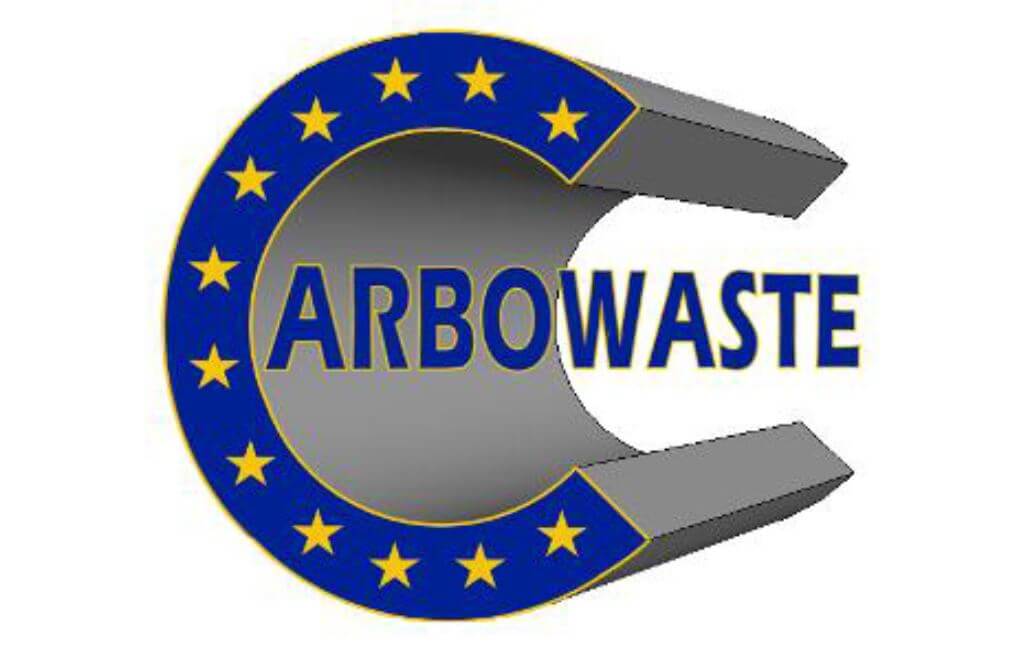
CARBOWASTE
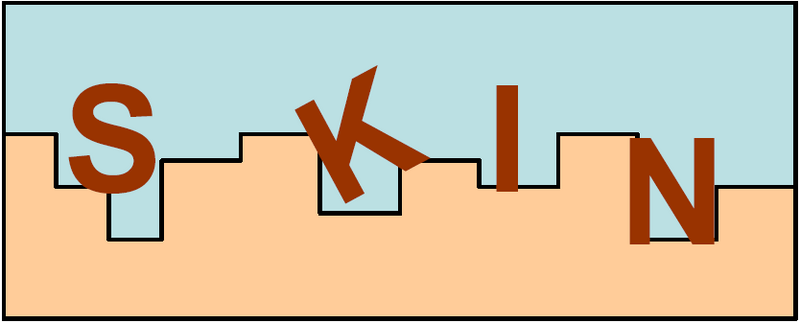
SKIN

ReCoSy
EUROPART
EUROTRANS

RED-IMPACT

PREDIS
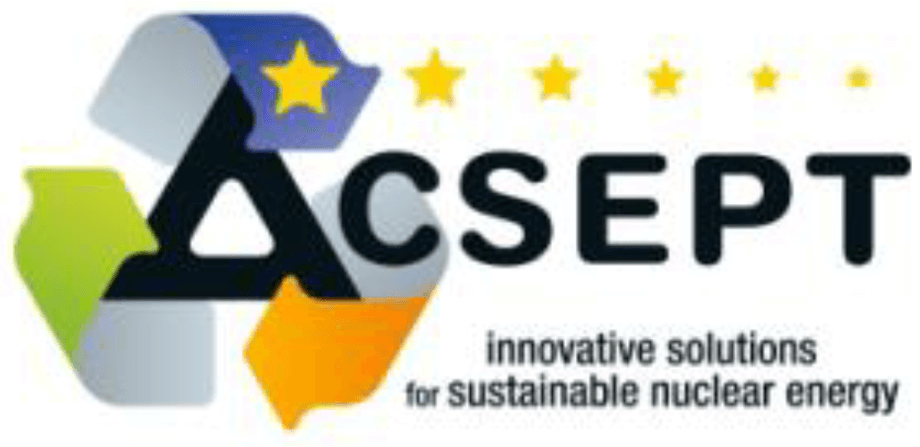
ACSEPT

LOMIR









